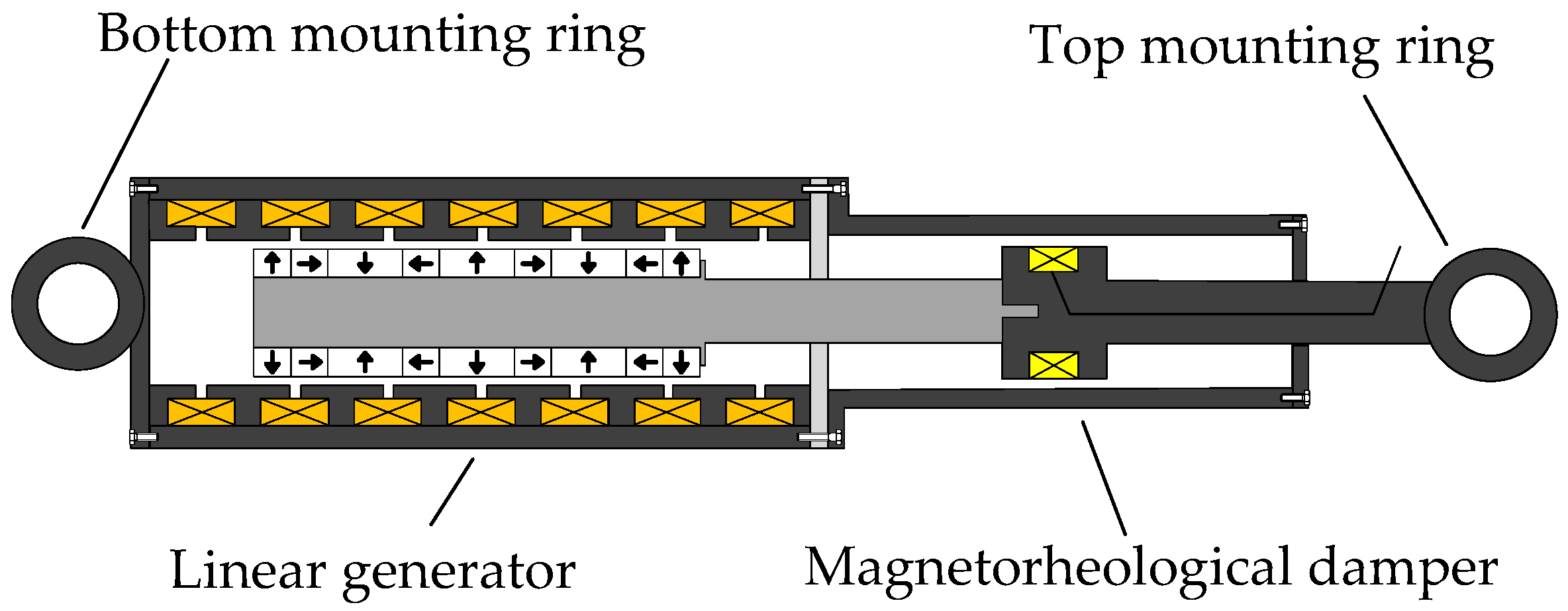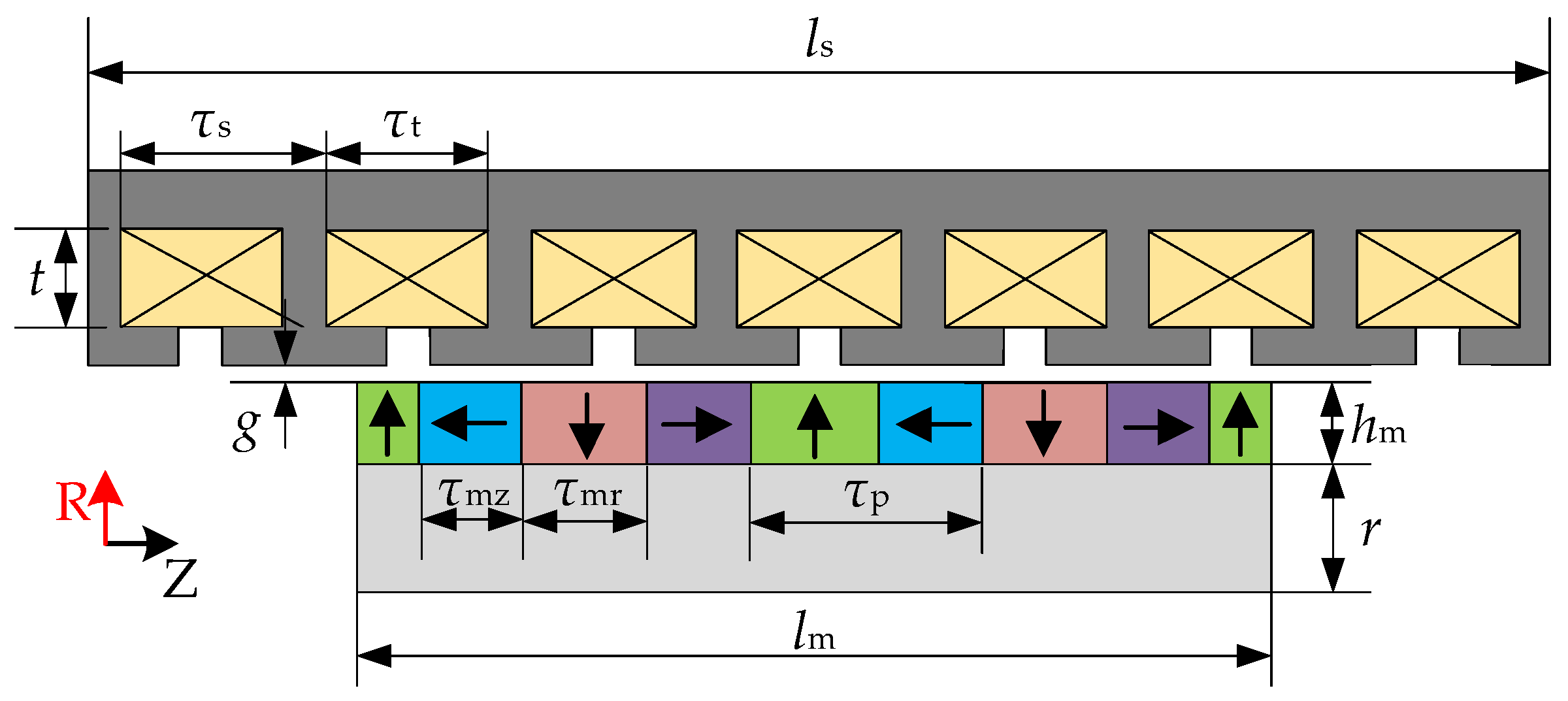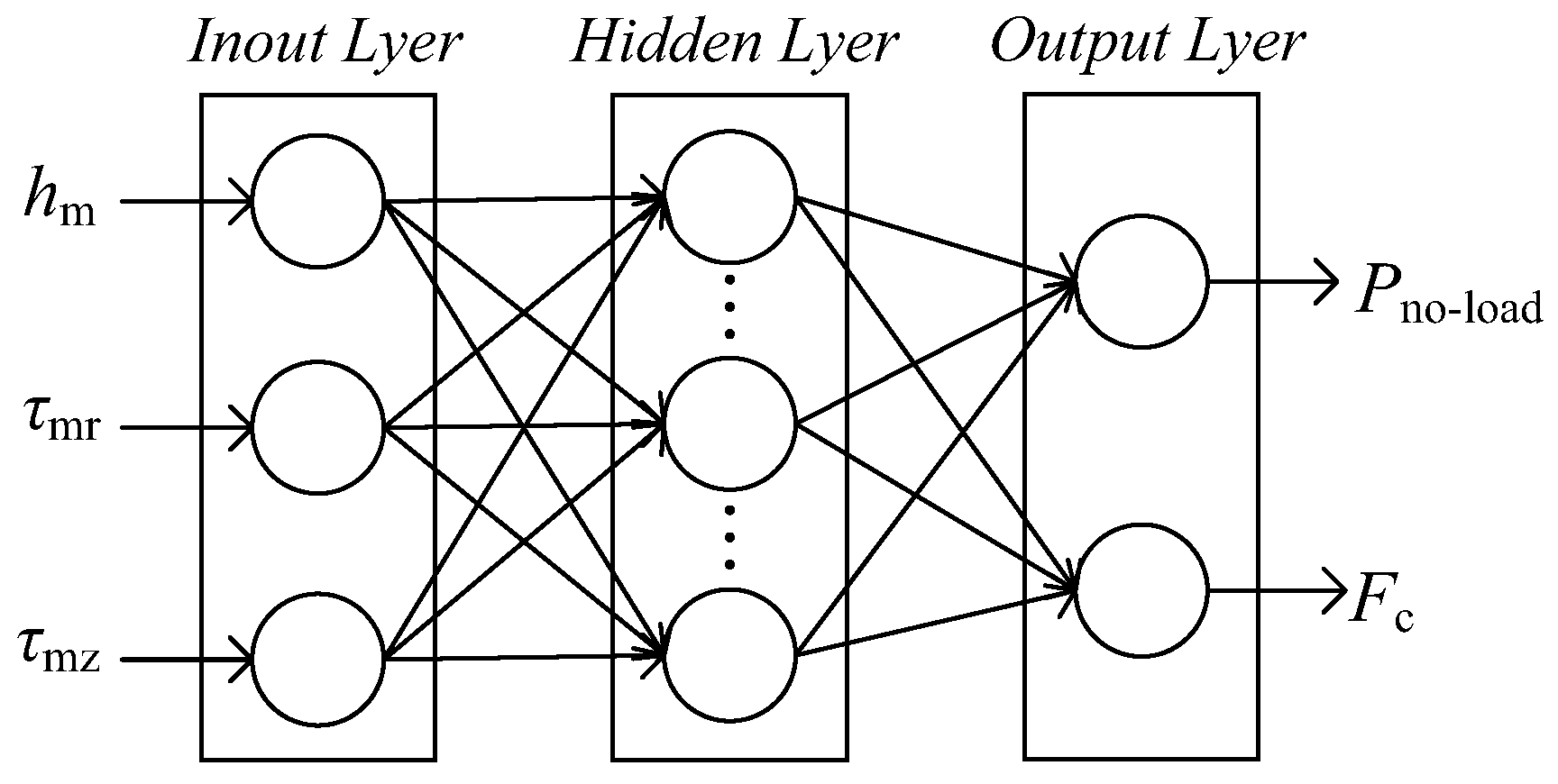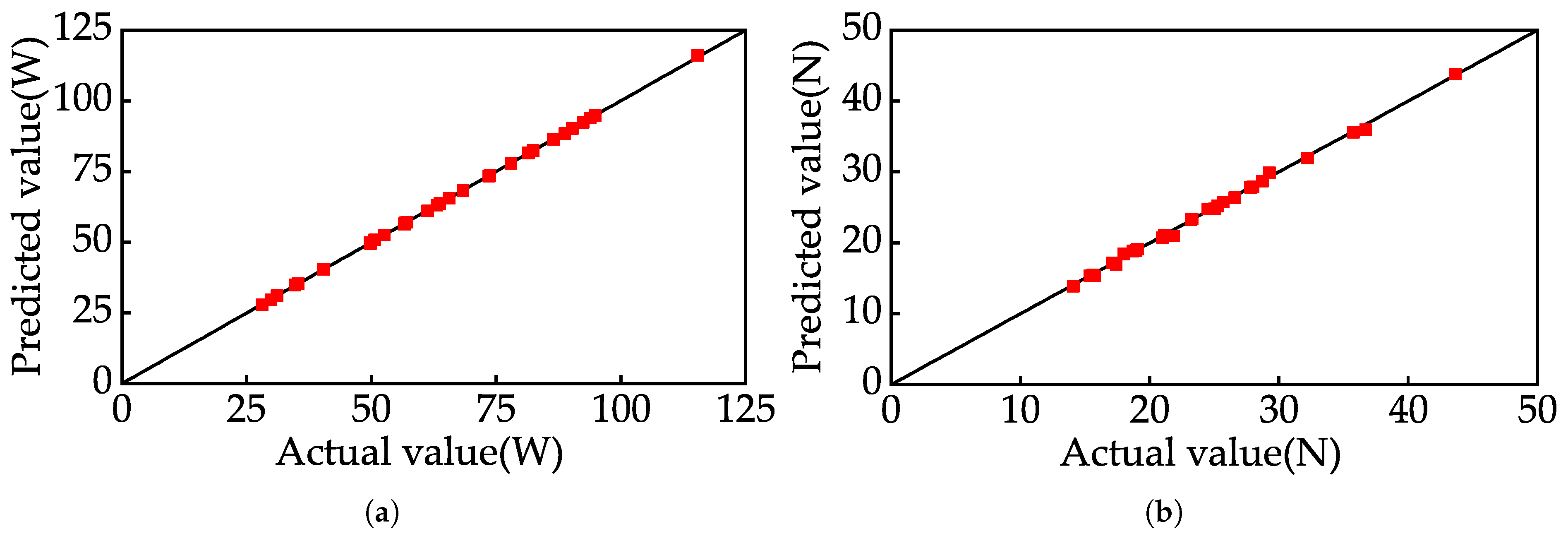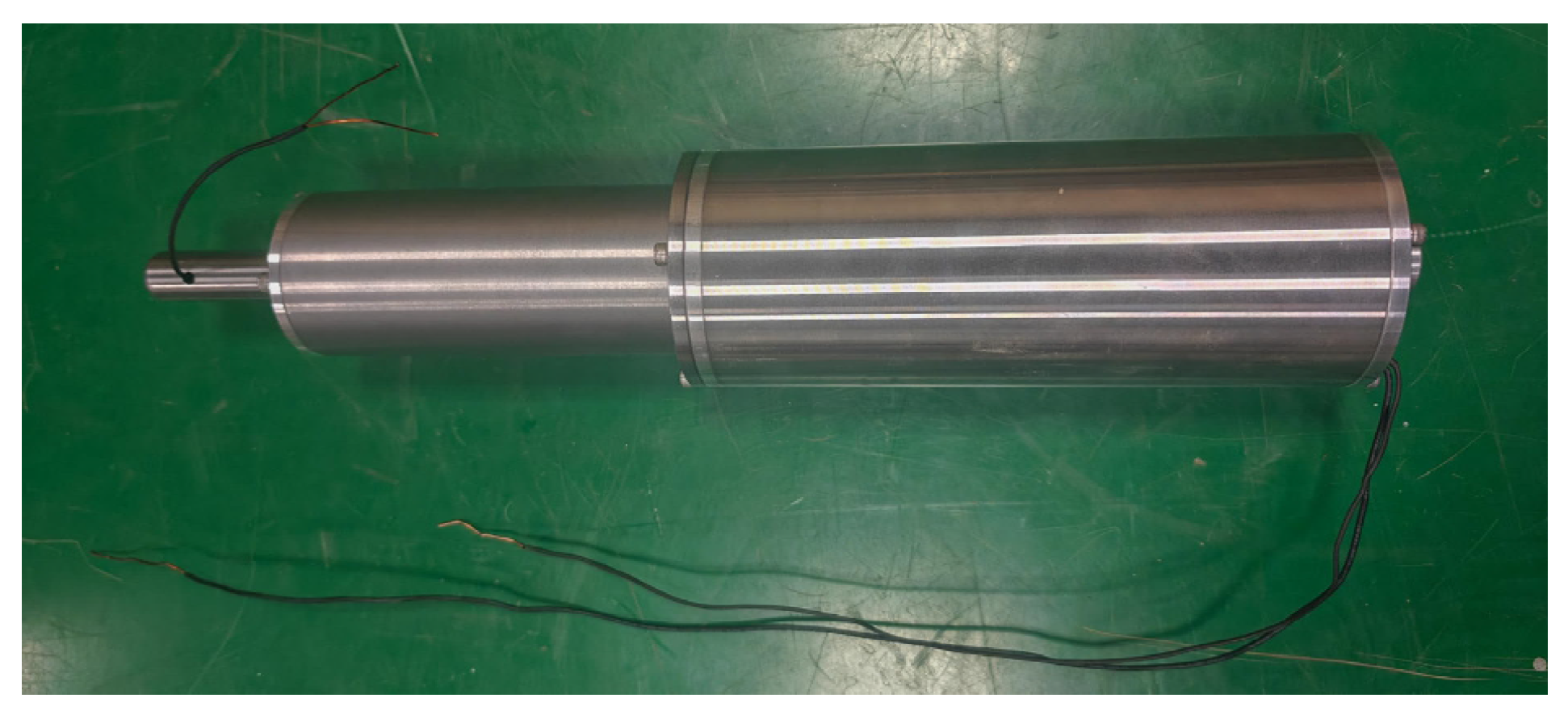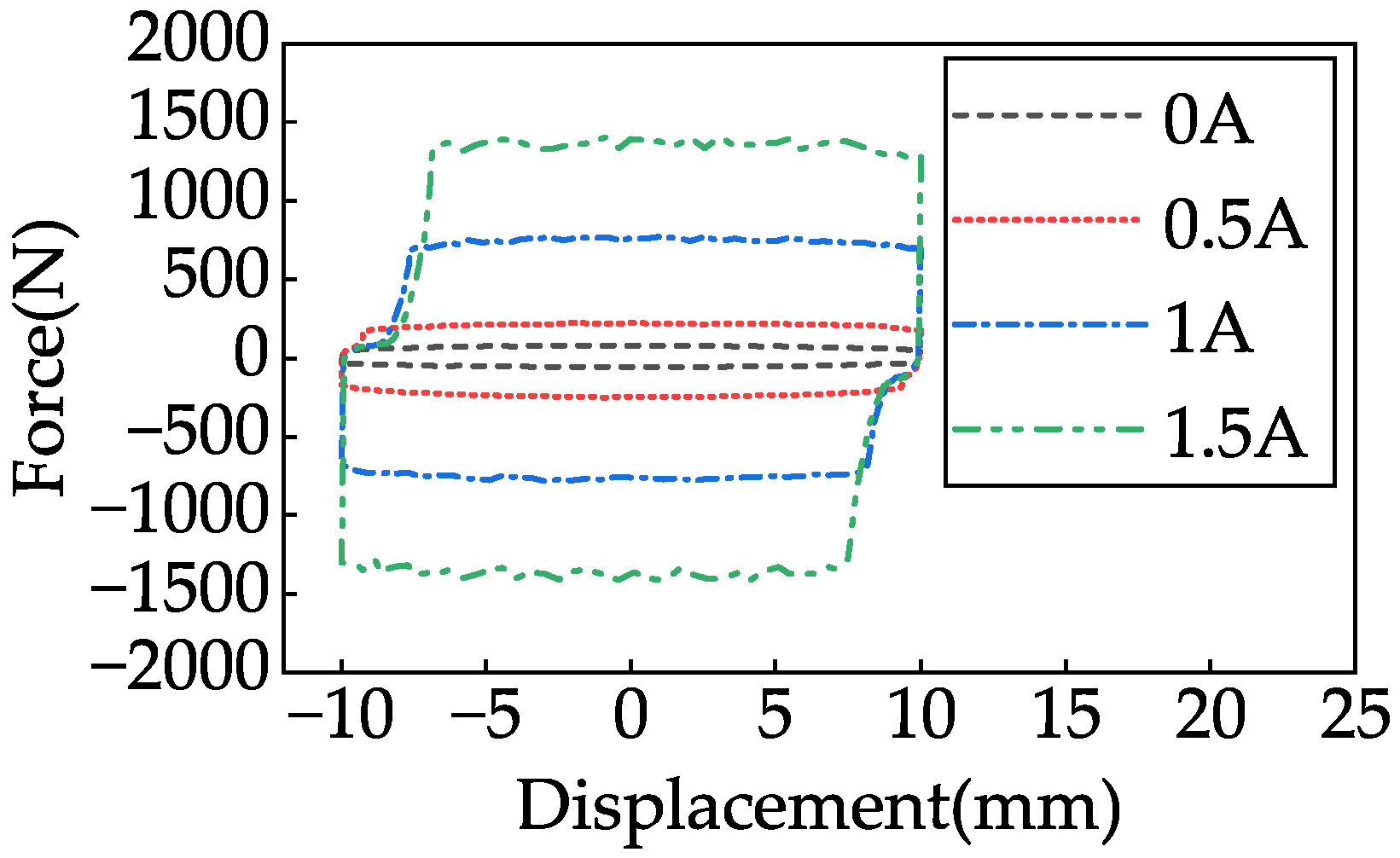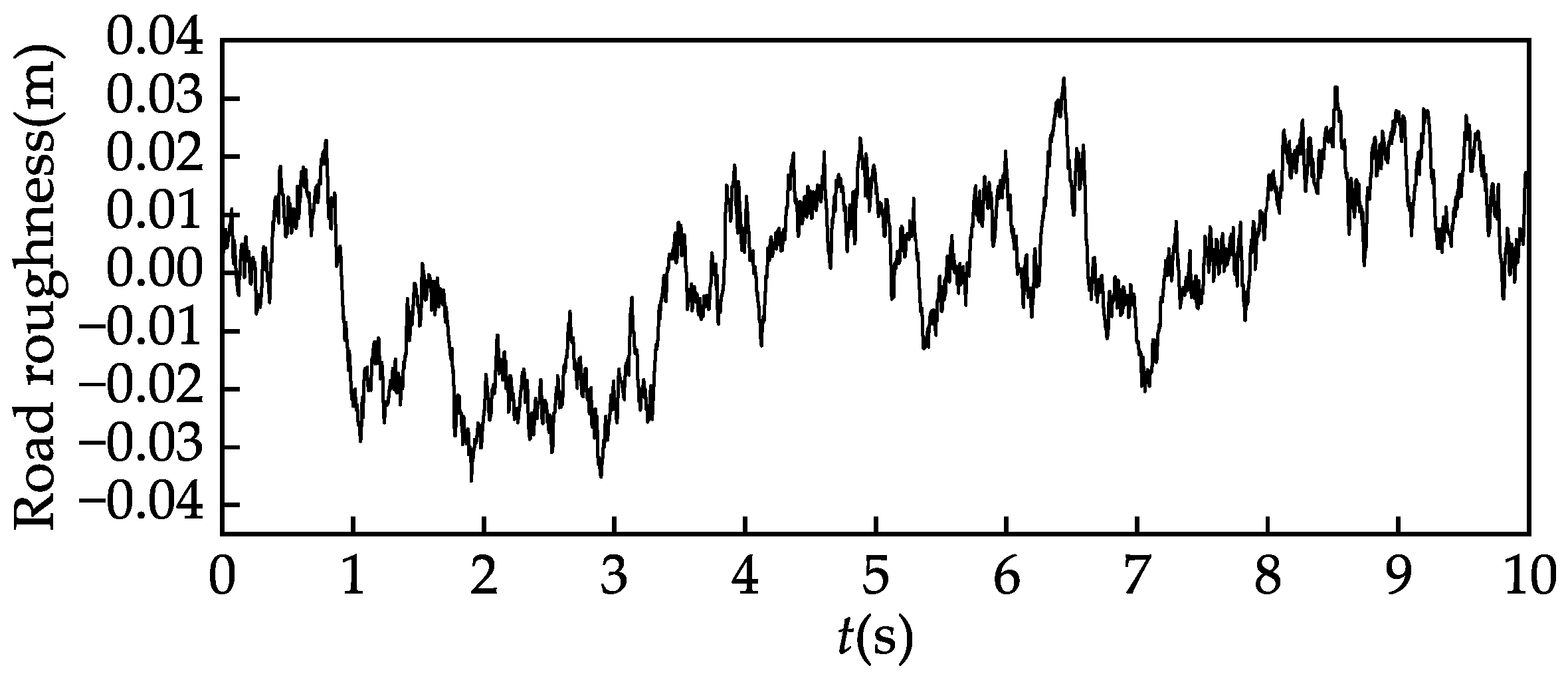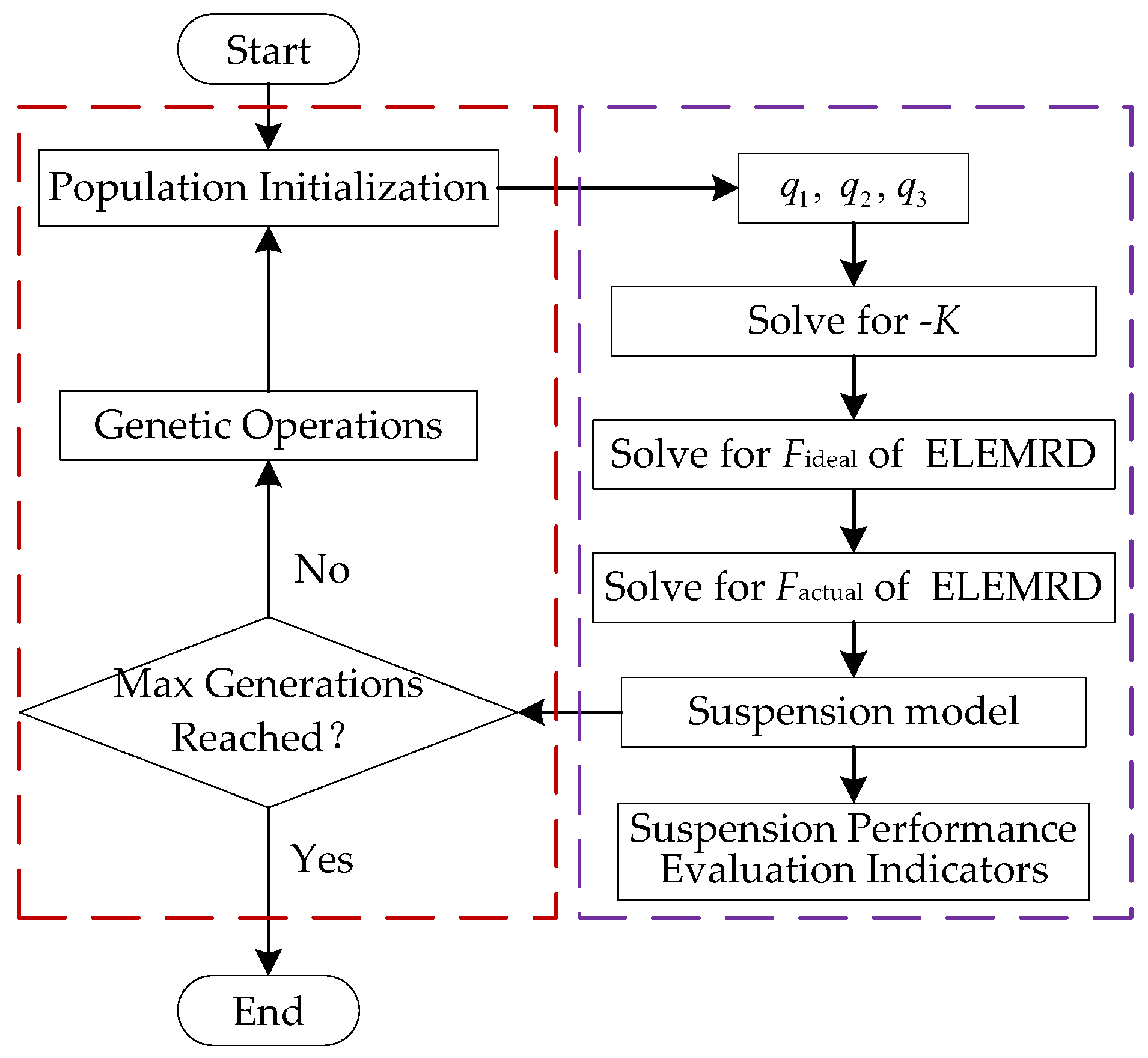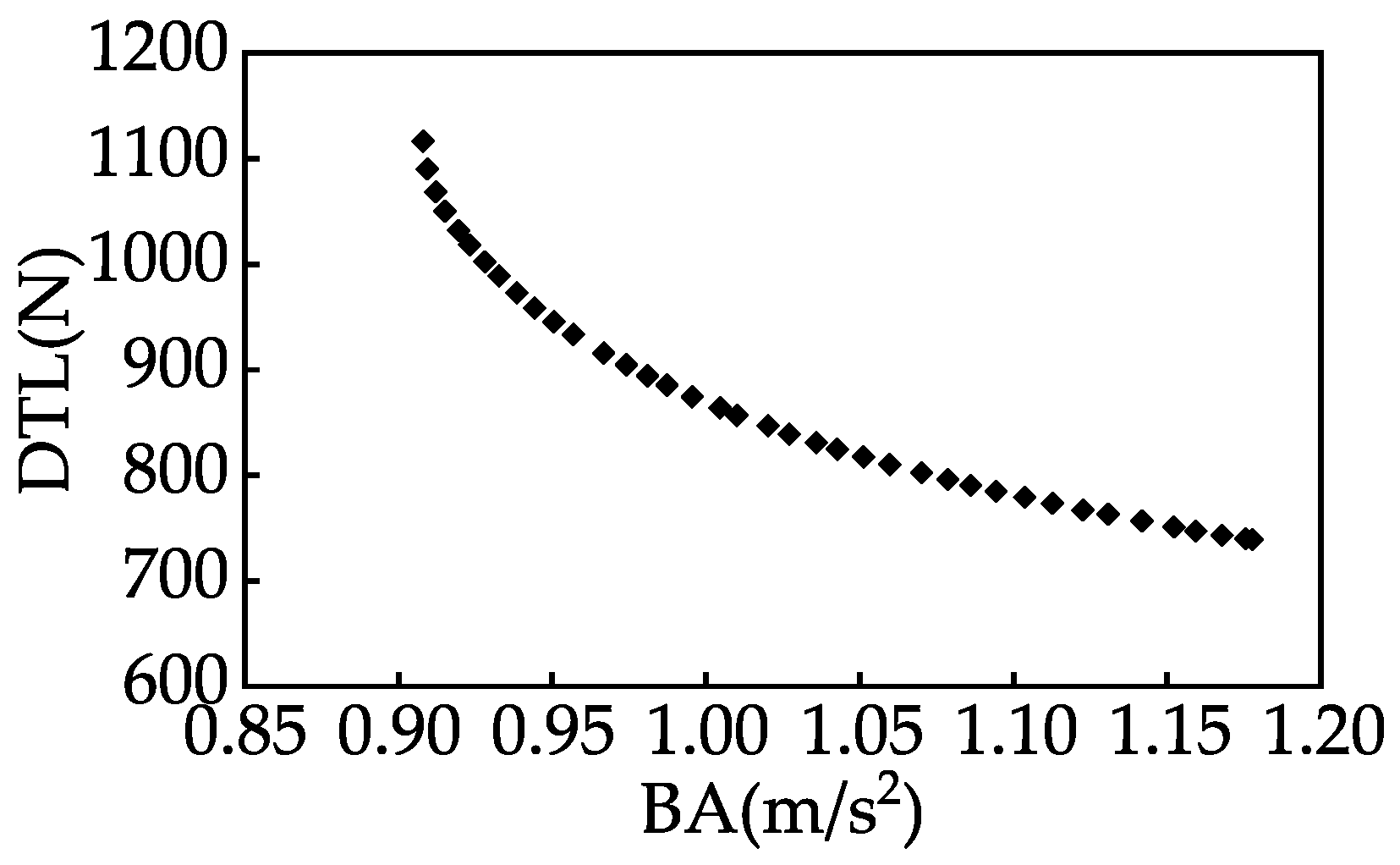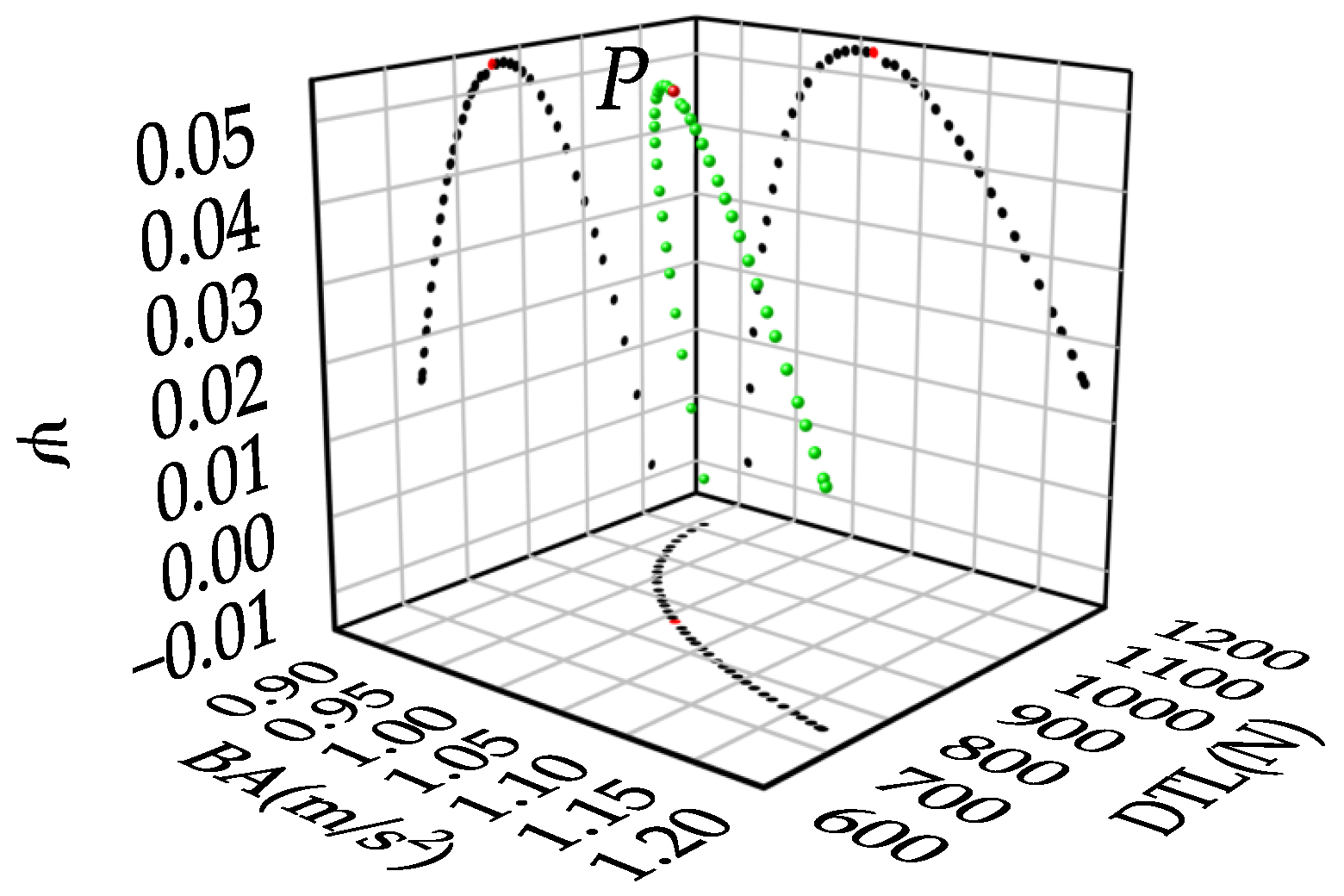1. Introduction
With increasing awareness of energy efficiency and environmental protection, the automotive industry is undergoing a shift toward electrification and energy conservation [
1]. This shift has promoted the development of electric drive systems and stimulated ongoing innovation in various energy-saving technologies [
2,
3]. Notable advances have been achieved in regenerative braking, while vibration energy recovery from suspension systems has also emerged as an active area of research [
4,
5,
6]. The suspension system, a fundamental component of the vehicle chassis, plays a key role in buffering and attenuating body vibrations induced by road irregularities. These vibrations affect not only ride comfort but can also compromise driving safety under severe conditions. Conventional suspension systems rely on hydraulic dampers to convert vibration energy into heat, which is subsequently dissipated into the environment [
7]. This process results in energy loss and may cause a decline in damping force due to fluid temperature rise. As a result, the study of vibration suppression and energy recovery in suspension systems holds considerable research value.
Vehicle suspension systems are generally categorized as passive, semi-active, or active. Their cost and performance increase progressively across these types, with semi-active suspensions offering a favorable balance between the two factors [
8]. Among semi-active systems, MRDs have gained considerable attention owing to their distinctive advantages [
9,
10,
11]. These dampers exploit the characteristics of magnetorheological fluids to adjust the damping force by modulating the magnetic field strength, enabling dynamic control of suspension performance. They respond rapidly to changes in road conditions and provide optimal damping across diverse operating scenarios. Integrating MRDs with energy recovery devices presents an effective approach for both vibration suppression and energy regeneration in suspension systems. This concept can be traced back to early research on utilizing vibrational energy to power electrorheological dampers [
12]. Compared to electrorheological dampers, MRDs simply replace electric field control with magnetic field control.
To enhance the integration of MRDs with energy recovery devices, extensive research has been conducted, resulting in various MRD designs featuring energy regeneration capabilities. Among these, electromagnetic energy-regenerative MRDs are the most widely adopted. This type of damper operates on the principle of electromagnetic induction, converting suspension motion into movement that intersects magnetic field lines, thereby transforming vibration energy into electrical energy [
13]. Based on the motion characteristics of the electromagnetic energy recovery device, these MRDs can be classified into rotary and linear generator types [
14]. The rotary type typically employs a permanent magnet rotary generator as the energy recovery device. However, since suspension motion is linear, this damper requires an additional mechanism to convert motion. Guan et al. realized energy regeneration by combining a ball screw mechanism with a rotary permanent magnet DC generator, using the generated electrical energy to power the MRD [
15]. This self-powered feature improved the independence and reliability of MRD operation. Dong also utilized a ball screw and rotary generator for energy recovery but arranged the MRD and generator in a parallel configuration [
16]. Compared to the series configuration, the parallel configuration is structurally simpler and easier to maintain, but it results in a larger overall volume. Li et al. designed a self-powered MRD based on a double-link motion conversion mechanism [
17]. This mechanism achieves relatively high power generation efficiency, though it occupies more space. The motion conversion mechanism increases the overall volume and weight of the system, which is unfavorable for lightweight and compact suspension design in passenger vehicles. It is also prone to wear, looseness, and mechanical failure, thereby increasing maintenance difficulty and cost while reducing system stability and reliability. In addition, mechanical conversion introduces friction, backlash, and impact losses, and the associated large rotational inertia can lead to delayed system response.
The linear motor type typically employs high power density tubular permanent magnet linear motors, which can also be applied to vehicle braking and gear shifting [
18,
19]. Although the output power of a linear generator is at least 21% lower than that of a rotary generator of the same size, the linear generator can directly utilize the suspension’s linear motion to achieve energy regeneration [
20]. Hu et al. integrated a linear generator into the piston head of the MRD, enabling the recovery of vibration energy during the piston head’s linear motion [
21]. This design not only realizes both damping and energy regeneration functions, but also enables self-sensing by determining the relative position between the piston and the outer cylinder based on the regeneration voltage. An alternative integration approach involves placing a multi-pole linear generator on the outer surface of the MRD’s outer cylinder [
22,
23]. Although coaxial and radial layouts offer high integration levels, they require dedicated magnetic field isolation components, which increase design complexity. Moreover, optimizing such configurations often demands establishing global optimization objectives, resulting in increased optimization difficulty.
Building on preliminary progress in the structural design of energy regeneration, researchers have increasingly focused on dynamic modeling and performance analysis of energy-regenerative magnetorheological suspension systems to promote their engineering applications. Jian et al. developed a novel semi-active magnetorheological suspension system integrating a parallel magnetorheological damper with a tubular linear permanent magnet synchronous motor (TLPMSM) [
24]. The study found that incorporating the TLPMSM slightly increased the amplitudes of both the sprung and unsprung masses but did not change the overall motion trend. This suggests that integrating energy regeneration devices into semi-active magnetorheological suspension systems is feasible. Zhang et al. developed an electromechanically coupled dynamic model of an energy-regenerative semi-active magnetorheological suspension system and conducted a time-domain analysis [
25]. The results showed that, under self-powered mode, the velocity amplitude with semi-active control was significantly lower than that with passive control, demonstrating the effectiveness of the self-powered semi-active MR suspension. A trade-off exists between suspension vibration isolation performance and vibration energy harvesting capability. Gao et al. applied an adaptive optimal fault-tolerant control algorithm that improved both vibration isolation and energy harvesting performance, thus partially mitigating the conflict between the two [
26]. In addition to achieving adjustable damping force under self-powered mode, Zhu et al. also realized variable stiffness in this mode [
27,
28]. This advancement significantly enhanced vibration isolation performance while reducing system complexity. These studies collectively demonstrate that integrating energy regeneration devices into semi-active magnetorheological suspension systems is both feasible and effective.
Based on the above discussion, developing a semi-active magnetorheological suspension system that integrates vibration suppression and energy regeneration holds significant research value. This system combines semi-active magnetorheological control with an energy recovery mechanism, improving vehicle dynamic performance and energy utilization efficiency. It also shows promising application potential. Therefore, a compact and structurally simple ELEMRD is designed in this study. Axially integrating the single-phase permanent magnet linear generator based on a Halbach array with the MRD eliminates the need for motion conversion mechanisms, thereby reducing structural complexity. This approach enables compact packaging while facilitating subsequent maintenance. Moreover, the coaxial configuration helps reduce magnetic field interference. Compared to other integration methods, this scheme achieves a balance among structural simplicity, packaging compactness, and energy conversion efficiency. A neural network surrogate model was employed to optimize the structural parameters of the energy regeneration device, enhancing its compatibility with the suspension system. A prototype of the ELEMRD was fabricated and subjected to experimental testing. Based on this, a novel electromagnetic linear semi-active magnetorheological suspension system is proposed, and its vibration control and energy regeneration performance under LQR control are analyzed.
The organization of this paper is as follows:
Section 2 presents the structure and working principle of the newly designed ELEMRD.
Section 3 employs a neural network surrogate model to optimize the key parameters of the energy-regenerative device, followed by the fabrication and experimental testing of the ELEMRD prototype.
Section 4 establishes the model of the electromagnetic linear energy-regenerative magnetorheological semi-active suspension system.
Section 5 presents a simulation-based comparative analysis of the vibration attenuation and energy regeneration performance of the proposed system under LQR and PID control. Finally,
Section 6 draws the conclusions.
3. Parameter Optimization of ELEMRD
To enhance compatibility with the suspension system, this paper proposes an optimized design of the linear generator.
Figure 3 illustrates the optimization workflow. The fundamental steps of this process are as follows. First, a specified number of sample parameters are uniformly generated within the optimization space. Second, these sample parameters are substituted into the finite element model to obtain simulation results. Third, a neural network surrogate model is constructed using the sample parameters and simulation results. Fourth, the accuracy of the surrogate model is assessed; if the fitting accuracy is insufficient, the sample size is increased. Finally, the Non-dominated Sorting Genetic Algorithm II (NSGA-II) [
29] is employed to optimize the surrogate model. Compared to simplified analytical methods, finite element optimization can more accurately simulate the complex magnetic field distribution inside the generator, thereby improving optimization accuracy. Compared to direct iterative optimization using transient finite element models, surrogate models significantly reduce the optimization time while maintaining accuracy.
3.1. Mathematical Model of Optimization
The optimization formulation consists of three fundamental elements: optimization parameters, the objective function, and constraint conditions. The optimal parameter configuration is obtained by solving this constrained optimization problem.
(1) Objective Function: Enhancing energy recovery efficiency is a key goal in designing energy-regenerative suspension systems. The regenerative power output of the linear generator directly indicates the suspension system’s energy recovery capability. Therefore, maximizing the root mean square (RMS) of the no-load regenerative power is selected as one of the optimization objectives. The cogging force of the linear generator varies periodically with the relative position between the mover and stator, representing an uncontrollable force. At times, the mover must overcome this force to operate properly, leading to unnecessary energy losses. If the cogging force is too large or fluctuates sharply, the suspension may fail to respond sensitively to small vibrations. Optimizing the cogging force helps reduce additional energy consumption, enhance power generation efficiency, and ensure better controllability of the suspension’s dynamic response. Therefore, minimizing the peak cogging force is chosen as another optimization objective.
(2) Optimization Parameters: The operating principle of the linear generator is based on Faraday’s law of electromagnetic induction. The magnetic field strength produced by the permanent magnet directly determines the generator’s power generation capability. The cogging force is a periodic force resulting from the interaction between the permanent magnet and the stator slots. When the slot-pole combination is fixed, the cogging force magnitude mainly depends on the permanent magnet’s size.
Figure 4 illustrates the schematic diagram of the linear generator’s structural dimensions, while
Table 1 lists the corresponding dimensional parameters. The permanent magnet thickness
, the length of the axially magnetized permanent magnet
, and the length of the radially magnetized permanent magnet
are selected as optimization parameters.
Table 2 presents the optimization parameters and their value ranges.
(3) Constraints: Considering that the designed suspension stroke is ±40 mm, the stroke
S of the linear generator’s mover should not be less than 80 mm. The permanent magnet pole pitch is
. The ratio between the slot pitch
and the permanent magnet pole pitch
is 9:10. The permanent magnet array of the linear generator consists of four poles, and there are seven slots. Therefore, the stroke of the mover
S is:
The mathematical model for optimizing the linear generator can be formulated as follows:
3.2. Construction of Neural Network Surrogate Model
To reduce optimization time and enhance computational efficiency, this study develops a neural network surrogate model to approximate the relationship between the optimization parameters and the objective functions of the linear electromagnetic generator. The NSGA-II algorithm is then applied to perform the optimization.The neural network model learns from input data and effectively approximates the nonlinear functional relationship between input variables and output responses. It consists of adjustable weights and biases that represent the connection strengths between neurons during training. The output of the neural network model can be expressed as:
where
Y is the output vector,
X is the input vector,
W is the weight matrix,
B is the bias vector, and
is the activation function that introduces the nonlinear transformation.
A neural network typically consists of an input layer, one or more hidden layers, and an output layer. For the optimization model of the linear generator, the input layer is defined by the permanent magnet thickness
, the length of the axially magnetized permanent magnet
, and the length of the radially magnetized permanent magnet
. The output layer corresponds to the no-load regenerative power
and the peak cogging force
. Because the number of inputs and outputs in the neural network model is relatively small, there is only one hidden layer, which consists of 14 neurons. The activation function used in the hidden layer is the tansig function, while the output layer employs the purelin function. The structure of the neural network for the linear generator is illustrated in
Figure 5.
Constructing a neural network surrogate model requires an initial dataset. One main source of inaccuracy in surrogate modeling is the insufficient number and non-uniform distribution of sample points in this dataset. In this study, the Optimal Latin Hypercube Design (OLHD) is used to generate the initial dataset. OLHD improves the uniformity of sample distribution in high-dimensional space through algorithmic optimization [
30]. This method ensures a more uniform spatial distribution of sample points, even with a relatively small sample size.
The procedure for establishing the neural network surrogate model is as follows: In total, 120 and 30 sets of sample parameters are generated within the optimization parameter space using the OLHD method, serving as the training and test sets, respectively. These 150 sample sets are then input into the JMAG finite element simulation model to obtain corresponding actual values, with the mover velocity fixed at 0.4 m/s. Finally, the neural network surrogate model is constructed using the 120 training samples and their corresponding simulation results.
3.3. Accuracy of Neural Network Surrogate Model
If the surrogate model achieves higher fitting accuracy, the prediction error can be reduced accordingly, thereby improving the accuracy of the subsequent optimization results based on the model. Therefore, evaluating the fitting performance of the neural network surrogate model is essential. In this study, the fitting accuracy of the surrogate model is evaluated using the coefficient of determination (
) in combination with the root mean square error (RMSE). The expressions for these two metrics are given as follows:
where
is the actual value of the
i-th sample point,
is the predicted value of the
i-th sample point obtained from the surrogate model, and
is the mean of the actual sample values.
The coefficient of determination
ranges from 0 to 1, with values closer to 1 indicating higher fitting accuracy of the surrogate model [
31]. The root mean square error (RMSE) measures the average deviation between the predicted and actual values. The
and
are calculated using the actual and predicted values from the neural network surrogate model for the 30 sample points in the test set, as shown in
Table 3.
As shown in
Table 2, the
values of the neural network surrogate model are very close to 1, and the RMSE values are extremely small, indicating high fitting accuracy. To further validate the fitting accuracy of the neural network model, the actual and predicted values for the 30 sample points in the test set were compared, as shown in
Figure 6. In this figure, a black line passing through the origin at a 45-degree angle represents points where the predicted values equal the actual values. The sample points for both the cogging force and no-load regenerative power are closely distributed around this line. This demonstrates that the prediction errors between the neural network surrogate model and the finite element simulation results are minimal. Therefore, the neural network surrogate model developed in this study is employed to replace the finite element simulation model for key parameter optimization of the linear generator.
3.4. Optimization Results
The NSGA-II algorithm was employed to optimize the neural network surrogate model, and the Pareto front for
and
is shown in
Figure 7.
As shown in
Figure 7, there is a trade-off between increasing
and reducing
. The Pareto front reveals two extreme cases, where either both
and
reach their maximum values, or both reach their minimum values, represented by points
and
on the Pareto front. The optimization results for these two extremes are summarized in
Table 4.
From
Table 4, it is evident that through optimization, the maximum
reaches 116.2 W; however, at this point, the
is 45.8 N, which is unfavorable for the stable operation of the suspension. The minimum
is 8.7 N, but this results in a reduced
of only 24.9 W, indicating low energy conversion efficiency.
Furthermore, as shown in
Figure 7, it is evident that along the Pareto front, as
increases, the growth rate of
initially accelerates before gradually slowing down. The point
on the Pareto front represents the inflection point of this growth rate. Therefore, the parameters corresponding to
are chosen as the final optimization parameters, as they strike a balance between a relatively high
and a relatively low
. A comparison between the optimized and initial designs is shown in
Table 5. Following optimization, the no-load regenerative power
of the linear generator increased by 14.2%, while the peak positioning force
decreased by 49.7%. The optimized parameters were incorporated into the finite element model for simulation.
Figure 8 compares the initial and optimized designs in terms of no-load regenerative power and cogging force.
3.5. Bench Test of ELEMRD
To investigate the damping and power generation performance of the designed ELEMRD, a prototype was fabricated, as shown in
Figure 9. The test setup for the ELEMRD bench experiment is presented in
Figure 10. It mainly consists of a vibration exciter, the ELEMRD prototype, a controller, a power supply, a driver, a digital oscilloscope, and a force sensor. One end of the ELEMRD is connected to the test stand beam, while the other end is attached to the vibration exciter. The designed prototype has a diameter of 80 mm and an axial length of 421 mm, making it suitable for installation within the packaging constraints of a typical passenger vehicle suspension system. The excitation coil of the prototype has a resistance of approximately 1.5
and a maximum operating current of 1.5 A, resulting in a maximum power consumption of 3.4 W. The low power consumption makes it well-suited for use in suspension applications.
According to the Chinese automotive industry standard QC/T 491-2018 [
32], the damping performance of the ELEMRD prototype was tested using a harmonic excitation with an amplitude of 10 mm and a frequency of 8.3 Hz. The excitation current of the MRD was set to 0 A, 0.5 A, 1A, and 1.5 A using the controller. The corresponding damping forces under different current levels are shown in
Figure 11. When the input current is 0 A, the maximum damping force output by the MRD is 81 N. Neglecting friction, the viscous damping coefficient of the MRD is approximately 156 N/(m/s). When the input currents are 0.5 A, 1 A, and 1.5 A, the maximum output forces are 249 N, 784 N, and 1415 N, respectively. As the excitation current increases, the output force of the MRD also increases.
Figure 12 compares the simulated and experimental values of the maximum output force at different current levels. Discrepancies exist between the simulated and experimental results, with errors of 12.5%, 11.6%, 3.2%, and 6.1%, respectively. These discrepancies are relatively complex and mainly arise from four sources: (1) limitations in magnetic field simulation accuracy and the applicability of the Bingham constitutive model; (2) zero-field viscosity deviation and particle sedimentation effects inherent in the magnetorheological fluid; (3) the influence of the nonlinear characteristics of magnetic materials on the actual magnetic flux distribution; (4) structural deviations introduced during the manufacturing and assembly processes. To address these issues, the design process will be further optimized in future work to improve modeling accuracy and enhance the overall reliability of the design.
To analyze the energy regeneration performance of the ELEMRD prototype, harmonic excitations with amplitudes of 5 mm and 10 mm and a frequency of 5 Hz were applied. A digital oscilloscope was used to record and store the generated instantaneous voltage signals. The voltage waveforms under the two amplitude conditions are shown in
Figure 13. As shown in
Figure 13, at the same frequency, increasing the vibration amplitude leads to a higher induced voltage in the ELEMRD. When the vibration amplitude is 5 mm, the RMS value of the induced voltage is 11.3 V. Given that the measured coil resistance is approximately 11.5
, the corresponding energy regeneration power of the ELEMRD is 11.1 W. When the vibration amplitude increases to 10 mm, the RMS voltage rises to 20.7 V, resulting in an energy regeneration power of 37.3 W.
6. Conclusions
In this study, a semi-active suspension system with an ELEMRD is proposed. This suspension not only achieves semi-active vibration control but also recovers vibration energy from the suspension system, thereby improving the overall energy efficiency of the vehicle. The main conclusions of this study are as follows:
(1) A new ELEMRD was designed by integrating a magnetorheological damper with a linear generator. A neural network-based surrogate model was employed to optimize the generator parameters, increasing no-load regenerative power by 14.2% and reducing cogging force by 49.7%.
(2) A prototype was fabricated and tested. Under an excitation current at 1.5 A, the MRD achieved a peak output force of 1415 N. At a 5 Hz excitation frequency, the no-load regenerative power reached 11.1 W and 37.3 W for vibration amplitudes of 5 mm and 10 mm, respectively.
(3) A semi-active suspension model incorporating the ELEMRD was developed and controlled using both LQR and PID control strategies. Compared to the passive suspension, both the LQR and PID controllers improve performance. The PID controller reduces sprung mass acceleration by 29.9% and suspension working space by 2.8%, but increases dynamic tire load by 41.0%, negatively impacting handling. LQR reduces acceleration by 14.2% and suspension working space by 7.5%, while increasing tire load by only 11.2%, achieving a better balance. Under Class C road conditions at 20 m/s, the PID controller achieves a peak regenerative power of 633.2 W and an RMS value of 80.2 W, significantly higher than LQR’s peak of 404.2 W and RMS of 49.8 W. However, this increase in regenerative power with PID control comes at the cost of degraded high-frequency tire–road contact performance, indicating a trade-off between energy regeneration and vehicle handling stability. Overall, the LQR controller provides a better balance between regenerative efficiency and ride comfort and stability.
This study preliminarily designed and validated an ELEMRD integrating magnetorheological damping and energy regeneration, combining structural optimization and system simulation to provide valuable insights for further research on energy-regenerative semi-active suspensions. The work focuses on the mechanical integration of the magnetorheological damper and linear generator, as well as the vibration control and energy recovery capabilities of a suspension system equipped with the ELEMRD. In the next stage, research will focus on energy harvesting and power management circuits to realize a closed-loop energy system, which will be further investigated through suspension bench testing.
